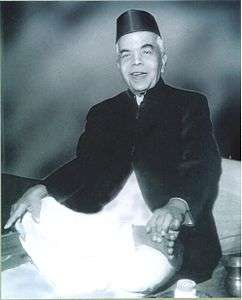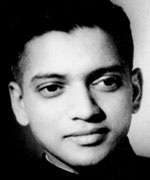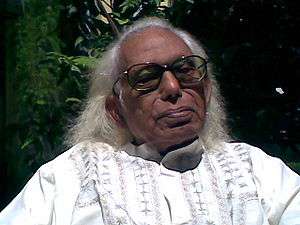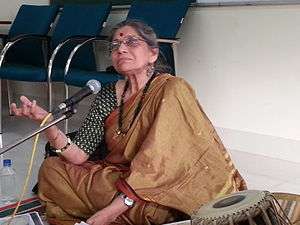Gwalior gharana
The Gwalior Gharana is one of the oldest Khyal Gharanas. The rise of the Gwalior Gharana started with the reign of the great Mughal emperor Akbar (1542–1605). The favorite singers of this patron of the arts, such as Miyan Tansen, first amongst the vocalists at the court, came from the town of Gwalior.
History
During the time of Mughal kings Ustad Naththan Pir Bakhsh and his maternal grandsons were the legendary Haddu, Hassu and Natthu Khan.[1] The main musician in the court at the time was Ustad Bade Mohammad Khan who was famous for his taanbaazi. Both Ustad Bade Mohammad Khan and Ustad Naththan Pir Bakhsh belonged to the same tradition of Shahi Sadarang.
Some sources believe that Ustad Naththan Pir Bakhsh settled in Gwalior and evolved the style features that led to this gharana. Others claim that individuals named Naththan Pir Bakhsh and Nathu Khan founded the gharana. The accepted version is that Naththan Pir Baksh left Lucknow in Uttar Pradesh to escape the professional rivalry with Ustad Shakkar Khan that had taken an ugly turn. He arrived in Gwalior with his maternal grandsons Haddu Khan and Hassu Khan.
Another great khayal singer, also originally from Lucknow, was Ustad Bade Mohammed Khan who brought the Taan into khayal singing. Haddu Khan and Hassu Khan further enhanced the style of the Gwalior gharana as we recognize it today. Hassu Khan died prematurely. Haddu Khan's sons, Rehmat Ali Khan and Ustad Bade Inayat Hussain Khan (1852–1922) was a widely acclaimed singer who liberated the Gwalior style from the methodical form it followed to the emotional style that he preferred.
Later it was the disciples of the duo-Ustad Haddu/Hassu khan- that both preserved as well as propagated the art. For instance, their pupils like Vasudeva Buwa Joshi, Ramkrishna Deva and Banne Khansaheb, who spread it further. It was Ramkrishna Deva's pupil BalRamkrishna buwa Ichalnikar , who took the Gwaliori Gaeki (singing stylistics) to Maharashtra.
However, the most beloved of the duo's was Banne khan,[2] who was previously a dhurpad and dhamar singer from Amritsar. He took the art to Punjab and Sindh. It is said that he lived liked a son in their house and firstly served the duo so much that he was then treated like the eldest son of the family. Later when he had learnt the art to its perfection, the man trained a good number of pupils in Punjab and Sindh to carry it further. His pupils included his cousin-brother Amir Khan (aka Meeran Bukhsh Khan), Gamman Khan, Bhai Atta, Ali Bukhsh/Kale Khan, Mian Qadir(sarangi), Bhai Wadhava/ Bhai Wasawa and so on.
Later Banne Khan became a musician at the court of the Nizam of Hyderabad.
After him, Amir khan too played an active role in spreading the art. He even taught the pupils of Balkrishna buwa Ichalnikar. However Later he focused upon his four sons. Out of whom, Pyare khan earned a great name. He introduced 'Khyal' genre in Afghanistan when he represented pre-partioned India in Afghanistan on the second annual celebration of its independence on 19 August 1992. He became a court musician there and the teacher of another Afghan court singer Qasim Afghan(alias Qasimju).[3] After which, he became the court musician at the court of Maharajadhiraj Maharawal Sir Jawaharlal of Jesairmal(1914-1949). After this he became the teacher of Seth Vishandas of Hyderabad, Sindh. He was also the teacher of Mahant Girdharidas of Bhumanshah.
Pyare Khan's younger brother Baba Sindhe Khan (aka baba Shinde Khan) (1885–18 June 1950) [4] was the teacher of Prof. Pnt B R Deodhar, Bade Ghulam Ali Khan[5] and Farida Khanam for sometime.
Later Pyare Khan's sons Ummeed Ali Khan[6] and Ghulam Rasool Khan too were the most known and respected Classical vocalists of their times and presently Ghulam Rasool Khan's two sons Hameed Ali Khan /Fateh Ali Khan too are referred as living legends of the Gwalior Gharana.[7]
Krishnarao Shankar Pandit (1893 – 1989) occupies an important place in the gharana (Gwalior) of Haddu Khan. He received his early musical tutelage from his father, Shankarrao Pandit, who was a disciple of Ustad Haddu Khan and Ustad Nathu Khan - the innovators of the Gwalior style and then Nathu Khan`s son Nissar Hussain Khan. Benefiting from intensive training from his father, Krishnarao`s regimen included pre dawn practice in the woods to perfect swara, laya and breath control. He was taught wrestling, gymnastics, yoga and swimming to develop stamina, and a range of three octaves.
A versatile musician, with a rich repertoire, Krishna Rao was equally at home in Khayal, Tappa and Tarana singing. He was considered a master of `layakari`. He became a well-known singer at an early age. In 1921 he was awarded the title Gayak Shiromani at the All India Congress. For a while, Krishna Rao served as court musician to Madhavrao Scindia of Gwalior. He also opened a music school in Gwalior, Shankar Gandharva Mahavidyalaya, in 1914. He was a respected performer for over thirty years and the various positions he held also included State Musician of the State of Satara (Maharashtra), Emeritus Professor of Madhav Music College, Gwalior and Producer Emeritus All India Radio and Doordarshan. For his contribution to the world of classical music, he received numerous awards including the Padma Bhushan in 1973 and the Tansen Award in 1980.
His disciples included his son Laxman Krishnarao Pandit, Sharadchandra Arolkar, Balasaheb Poochwale, and grand-daughter Meeta Pandit. He evolved an easy and independent notation system in 1914 and also published several books and articles in different journals and magazines.
Singing style
A distinguishing feature of the gharana is its simplicity, and one means to this is the selection of well-known ragas so that the listener is saved the effort of trying to identify the raga. While the khyal singer does include "Raga Vistar" (melodic expansion) and "Alankar" (melodic ornamentation) to enhance the beauty and meaning of the raga, there is no attempt to include the "Tirobhava" (using melodic phrases to obscure the identity of the raga) feature in the interest of adding interest or mystery to the listener's experience.
The singing itself places Bandish (the composition) at the heart of the presentation because of the gharana's belief that the full melody of the raga and guidance on its singing is provided by the bandish. The asthayi section is sung twice before the antara, to be followed by swar-vistar in medium tempo. This slow rendition of the notes is known as the Behlava, and is sung from Ma in the lower register to Pa in the higher register, following the pattern of the Aroha (ascent) and Avaroha (descent) of the raga. The behlava is divided into the asthayi (from Ma to Sa) and antara (from Ma, Pa, or Dha to Pa of the higher register). The Dugun-Ka-Alap follows in which groups of two or four note combinations are sung in quicker succession but the basic tempo remains the same.
The Bol-Alap is next in which the different words of the text are sung in different ways, to be followed by Murkis in which notes are sung with ornamentation to a faster pace. Bol-Taans entail the formation of melodic sequences with the words of the song. The other Taans, including the Gamak, follow.
The Sapat Taan is important to the Gwalior style and refers to the singing of notes in a straight sequence and at a Vilambit pace. Both Dhrupad and Khyal singing evolved in Gwalior and there are many overlaps. In the khyal style there is one form, Mundi Dhrupad, that incorporates all the features of dhrupad singing but without the Mukhda.
Common ragas include Alhaiya Bilawal, Yaman, Bhairav, Sarang, Shree, Hameer, Gaud Malhar, and Miya Ki Malhar.
Pioneers
- Nathan Pir Bakhsh
- Nathu Khan
- Haddu Khan
- Hassu Khan
- Ustad Qurban Hussain Khan
- Bade Inayat Hussain Khan
- Rehmat Ali Khan
Notable musicians
-

Vishnu Digambar Paluskar (1872–1931) founded Gandharva school in 1901.
-

Gururao Deshpande - (1889–1982)
-

Dattatreya Vishnu Paluskar (1921-1955) was a child prodigy from Nasik.
- Krishnarao Shankar Pandit[8]
- Pt. Nanubhaiya Telang (1879 - 1948) - Disciple of Bala Saheb Guruji who was the disciple of Ustad Haddu Khan
- Raja Bhaiya Poonchwale[9]
- Balakrishnabuwa Ichalkaranjikar (1849–1926, brought Gwalior gharana style to Maharashtra)
- Vishnu Digambar Paluskar - (1872–1931, disciple of Balakrishnabuwa Ichalkaranjikar, founded Gandharva Mahavidyalaya)
- Anant Manohar Joshi - (1881 - Unknown), disciple of Balakrishnabuwa Ichalkaranjikar and Sangeet Natak Akademi Awardee in 1955.
- Gururao Deshpande - (1889–1982)
- Vinayakrao Patwardhan - (1898-1975, Padma bhushan awardee in 1972)
- D. V. Paluskar - (1921-1955, child prodigy from Nasik, disciple of Vinayakrao Patwardhan)
- Ustad Rafique Khan
- Ustad Mian Bannay Khan Sahab
- Ustad Meeran Baksh Khan aka
- Ustad Amir Khan
- Ustad Gaaman Khan
- Ustad Pyare Khan
- Ustad Sendhay khan
- Ustad Mubarak Ali Khan
- Ustad Sendho Khan
- Ustad Beebay Khan
- Ustad Murad Ali Khan
- Ustad Ashiq Hussain Khan
- Ustad Qudratullah Khan
- Ustad Umeed Ali Khan
- Ustad Manzoor Ali Khan
- Ustad Ghulam Rasool Khan
- Ustad Ahmed Ali Khan
- Ustad Rehmat Ali Khan
- Ustad Hameed Ali Khan
- Ustad Fateh Ali Khan
- Ustad Waheed Ali Khan
- Karam Abbas Khan
- Roshan Abbas Khan
- Iqrar Waheed Ali Khan
- Tausif Ali Khan
- Latif Ali Khan
- Pt. Yashwant B. Joshi
- Aditya Khandwe
- Aditya Modak
- Pandit Madhup Mudgal
- Pandit Vinaychandra Maudgalya
- Pandit Gangadhar Rao Telang
Contemporary artists
-

Ustad Abdul Rashid Khan was the oldest exponent of the Gwalior gharana at 107 years.[1]
-

Malini Rajurkar performing at Argya 2011
-

Neela Bhagwat is known composing & performing thumris from a feminist perspective.
- ^ "Ustad Abdul Rashid Khan, India's oldest performing musician dies at 107". Hindustantimes.com. H T Media. 18 February 2016. Retrieved 19 February 2016.
- Abdul Rashid Khan - oldest exponent of the gharana, disciple of Chhote Yusuf Khan. Bharat bhushan (2013)[10] and Sangeet Natak Akademi (2009) awardee.
- Malini Rajurkar - disciple of Vasantrao Rajurkar, acknowledged master of Tappa and Tarana, Sangeet Natak Academy Awardee (2001).
- Pandit Vinayak Torvi - disciple of Pandit Gururao Deshpande, also influenced by Kirana, Agra and Jaipur gharanas.
- Veena Sahasrabuddhe - also influenced by Jaipur and Kirana gharanas.
- Ghulam Hassan Shaggan (1928-2015)- renowned khayal singer, disciple of his own father Ustad Bhai Lal Muhammad, Sitara-e-Imtiaz (Order of Excellence) awarded in 2000 from the Government of Pakistan.
- Neela Bhagwat
- Meeta Pandit
- Shashwati Mandal Paul ([11])
- Manjusha Kulkarni-Patil
- Arman Khan (1990–present) - After Sadarang son of Niyamat Khan belongs to the family of Miyan Tansen's daughter, is musical composer & one of the finest lyricist of Gwalior Gharana.
- Ustad ShahJahan Khan - (1992–present), The legendary & honorable Ustad ShahJahan Khan, bloodline of Miyan Tansen, is the king of dhrupad & Khyal (oldest hindustani classical singing genres). Excellency and perfection of his classical singing is the pride of Gwalior Gharana.
- Dr.Ashok Huggannanavar -Hails from a village yeraguppi near Hubli ,currently HOD in SDM College Honnavar,UttarKannada.Deciple of Sangameshwar gurav and Basavaraj Rajguru.He is a renowned singer noted for his unique voice and style of singing.
- Muslim Hassan Shaggan - grandson and disciple of Ghulam Hassan Shaggan.
- Vasundhara Komkali - wife of Kumar Gandharva and a recipient of the Sangeet Natak Akademi Award and the Padma Shri.
- Gulamfarid Vhora - Disciple of Padmabhushan Ustad Abdul Rashid Khan and Exponent Scholar of Gwalior at Surat
- Vikas Gangadhar Telang - Disciple and son of renowned musician of Gwalior Gharana Pt. Gangadhar Rao Telang, also learned from Uncle Pt. Krishna Narayan Telang.
- Bharat Telang - Disciple and son of renowned musician of Gwalior Gharana Pt. Gangadhar Rao Telang, also learned from Uncle Pt. Krishna Narayan Telang.
References
- ↑ Mukherji, Kumar Prasad (2006). The Lost World of Hindustani Music (2006 ed.). Delhi: Penguin Books. p. 57. ISBN 978-0-14-306199-1.
- ↑ Wade, Bonnie C. (1984-01-01). Khyal: Creativity Within North India's Classical Music Tradition. CUP Archive. ISBN 9780521256599.
- ↑ "Afghanland.com Afghanistan Ustad Qasim Afghan". www.afghanland.com. Retrieved 2016-01-06.
- ↑ "B. R. Deodhar". veethi.com. Retrieved 2016-01-06.
- ↑ "ITC SRA's Tribute to the Great Maestros of Hindustani Classical Music". www.itcsra.org. Retrieved 2016-01-06.
- ↑ "Ummeed Ali Khan". Vijaya Parrikar Library of Indian Classical Music. Retrieved 2016-01-06.
- ↑ "Oriental Traditional Music from LPs & Cassettes: Hameed Ali Khan & Fateh Ali Khan (Gwalior Gharana) - Vol. 2 - Lok Virsa CL-0023 (1987)". Oriental Traditional Music from LPs & Cassettes. 2011-06-12. Retrieved 2016-01-06.
- ↑ "Krishnarao Shankar Pandit". ITC Sangeet Research Academy. Retrieved 19 October 2014.
- ↑ Kumr, Ranee (29 March 2013). "Music from the 'school'". Retrieved 19 October 2014.
- ↑ "Padma Awards 2013: Full list". Zee News. 25 January 2013. Retrieved 10 October 2014.
- ↑ Sarvamangala, C.S (5 October 2012). "The eternal note". The Hindu. Retrieved 7 October 2014.